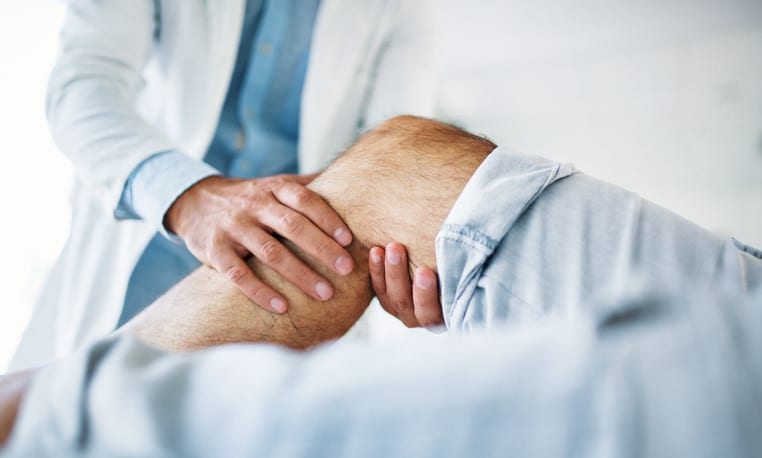Patellofemoral Pain: Treating Painful Kneecaps

Patellofemoral Pain Syndrome (PFPS) is one of the most common causes of anterior knee pain. This is also known as “runner’s knee” or “biker’s knee.” PFPS occurs as an overuse injury to repeated microtrauma, leading to peripatellar synovitis (inflammation within the knee cap). Predisposing conditions include but are not limited to: recurrent patellar subluxations, congenital malformations within the lower extremity, quadriceps weakness and anatomical abnormalities such as excess genu valgum or varum (bow-legged or knock-knees).
The syndrome presents as acute or insidious onset of anterior knee pain. It can be present with a knee effusion (edema) as well. Patients usually have trouble squatting, ascending and descending stairs. Common physical exam findings include knee effusion, crepitus with knee extension, pain with last 30 degrees of knee extension, rotation of the patella secondary to vastus medialis weakness, tight hip flexors, altered gait mechanics, increased Q angle of the hip, tight abductors of the lower extremity, or tight hamstrings. All of these conditions can increase the patellofemoral loading.
Doctors will likely order knee radiographs to assess the patellar position over the sulcus. The sunrise view of the knee is helpful in visualizing the patellofemoral articulation and femoral condyle height. An MRI is not helpful to assess PFPS, but articular or bone degeneration in the form of chondromalacia can be seen. A CT scan is helpful if growth plate injury or tumors/masses are suspected.
The vast majority of treatment is conservative. This includes controlling the symptoms by decreasing pain, increasing overall quadriceps strength and range of motion. Activity modification is key and education to reduce the pace of activities that increase patellofemoral stress such as climbing, jumping, squatting and bicycling are important to discuss. In bikers specifically, bike modifications such as adjusting saddle position, adjusting the rotation of the cleats and training distance/intensity is important as well. Icing for 10-15 minutes 4-6 times a day and NSAIDs as needed are vital to decrease inflammation in the acute phase. Physical therapy targeting the quadriceps with isotonic and isometric quadricep strengthening will gradually decrease patellofemoral loading. Stretching of the hamstrings, iliotibial band, adductors, vastus lateralis will further support healing. Patellar taping to allow pain-reduced range of motion and achieve muscle balance can be done by a physical therapist as well. Lastly, patellar bracing can provide vital proprioceptive feedback and prevent re-injury.
Surgical referral or treatment can be considered if conservative treatment fails after 6 months. Orthopedic surgeons may evaluate for lateral release of the knee capsule and retinaculum, patellar realignment, patellar tendon transfer or patellectomy.
References:
- Thomeé R, Augustsson J, Karlsson J. Patellofemoral pain syndrome: a review of current issues. Sports Med 1999; 28:245.
- Dixit S, DiFiori JP, Burton M, Mines B. Management of patellofemoral pain syndrome. Am Fam Physician 2007; 75:194.
- Crossley KM, Stefanik JJ, Selfe J, et al. 2016 Patellofemoral pain consensus statement from the 4th International Patellofemoral Pain Research Retreat, Manchester. Part 1: Terminology, definitions, clinical examination, natural history, patellofemoral osteoarthritis and patient-reported outcome measures. Br J Sports Med 2016; 50:839.
- Cutbill JW, Ladly KO, Bray RC, et al. Anterior knee pain: a review. Clin J Sport Med 1997; 7:40.
- Witvrouw E, Callaghan MJ, Stefanik JJ, et al. Patellofemoral pain: consensus statement from the 3rd International Patellofemoral Pain Research Retreat held in Vancouver, September 2013. Br J Sports Med 2014; 48:411.
- Baquie P, Brukner P. Injuries presenting to an Australian sports medicine centre: a 12-month study. Clin J Sport Med 1997; 7:28.
- Taunton JE, Ryan MB, Clement DB, et al. A retrospective case-control analysis of 2002 running injuries. Br J Sports Med 2002; 36:95.
- Lankhorst NE, Bierma-Zeinstra SM, van Middelkoop M. Factors associated with patellofemoral pain syndrome: a systematic review. Br J Sports Med 2013; 47:193.
